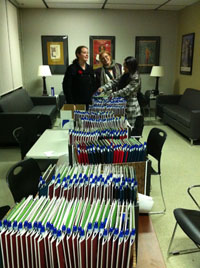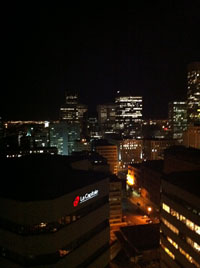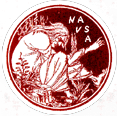2010 Conference Highlights: NAVSA 2010 (Montréal): “Victorian Scale and Perspective”
“Every object, however near the eye, has something about it which you cannot see, and which brings the mystery of distance even into every part and portion of what we suppose ourselves to see most distinctly.” (John Ruskin, Modern Painters I)
“It was so long since she had been anything near the right size, that it felt quite strange…” (Lewis Carroll, Alice’s Adventures in Wonderland)
The NAVSA 2010 conference in Montréal, organized by Jason Camlot, Michael Eberle-Sinatra and Monique Morgan, 
Conference Packets and student volunteerswill be remembered for the quality and coherency of the papers, lectures, seminars and workshops that defined it, and (from what we’ve heard) for the pleasures in food and drink that delegates experienced in the host city. Inspired by Ruskin’s idea of “the mystery of distance” and Alice’s thoughts on feeling the right size, the conference committee—consisting of a dozen faculty and students, plus the organizers—fine tuned the idea of a theme that encompassed size and distance into the final conference moniker, “Victorian Scale and Perspective.” The definition of the theme and brainstorming around plenary speakers and workshop/seminar leaders were performed in tandem, and the committee agreed upon its wish list of three keynote speakers and the final phrasing of the conference theme on the same day, June 20th, 2009, we believe it was.
The theme proved alluring and drew much interest and a strong number of (very strong) proposal submissions for individual papers and member-organized panels. We received approximately 470 paper submissions, and the organizing committee developed a first program of 270 conference papers, with about 54 of these constituting the eighteen member-organized panels, and the rest organized into panels by Jason, Michael and Monique. The theme was interpreted in myriad, ingenious ways, resulting in papers that considered scale and perspective in relation to literary genre and narrative point of view (of course),
Dino Franco Felluga and
Michael Eberle-Sinatra at the BanquetVictorian painting and architecture, technologies and methods of observation in Victorian science, gendered notions and material examples of the miniature and the gigantic, scales of reading and print production, and a surprising number of papers that approached the theme in the spirit of recovering texts and historical characters that had been lost from view due to temporal distance. Each of our plenary lecturers approached the topic according to his or her particular sense of interest and genius. Herbert Tucker entranced a packed lecture hall with a virtuoso keynote lecture (entitled “Perspective, Scale, and Everything: Victorian All in All”) that truly rang new notes from key, canonical Victorian texts. Bernard Lightman (“The Royal Panopticon in Perspective”) delighted and instructed us with the story of the architectural design and historical repurposing of The Royal Panopticon of Science and Art (aka Alhambra Theatre). And Regenia Gagnier (“Global Perspectives on the Literature of Decadence”) walked us through some of the major discoveries of the collaborative Global Circulation Project about the intercultural circulation of decadent form as manifest in literatures of France, Britain, China, Japan, Latin America, and Russia. Our workshop and seminar leaders (three of each) provided delegates with the opportunity to participate in discussion and exchange ideas on specific topics ranging from Queen Victoria’s portrait miniatures to late Victorian media.
In addition to proving alluring, and intellectually productive, the conference theme also turned out to seem almost maliciously predictive to the organizers when they were forced to put potential catastrophe into perspective: Out of the blue, they learned that the original hotel they had under contract
View from NAVSA Suite at
Delta Centre Ville (“malheureusement, pour des raisons administratives”) closed for business on Oct 7th (2010!), just a month before the conference was scheduled to begin. We were fortunate to find a replacement hotel within a week of learning the Grand Plaza had closed, and we believe our change to the Delta Centre Ville ultimately worked out very much for the better. The organizers are ever grateful for the messages of support and sympathy conference delegates conveyed to the organizers as they dealt with that unfortunate mess.
Fortunately, conference finances were stable from start to finish. We began with great seed funding from our three host institutions, Concordia, McGill and Université de Montréal, and then were successful in our efforts to procure a SSHRC conference grant. In addition to allowing us to pay for an opening reception, and add an extra glass of wine (or two) at the closing banquet, this additional financial support enabled us to provide travel honoraria for numerous graduate students presently studying Victorian literature at Canadian universities, and to remunerate the research assistants who worked so hard on the conference preparations. The organizers would like to acknowledge, in particular, the substantial work of Jayne Hildebrand (who did everything from work on the program and manage the book display to ask if you wanted Chicken or Fish), Celyn Harding Jones (who set up the initial paper-selection database), and Ann Ward (who managed registrations and designed and produced the paper program). These students, and the many others who volunteered during the conference, helped make NAVSA 2010 a gargantuan, humongous, magnificent success.

